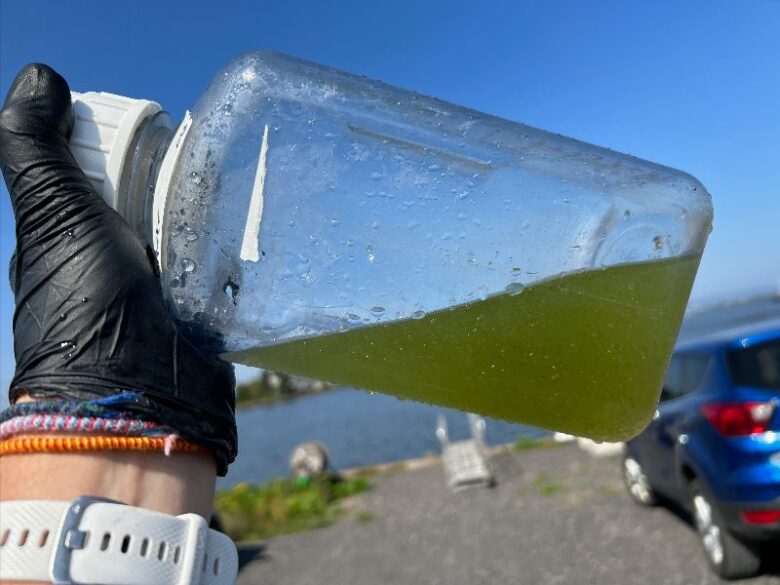By Danielle Kaeding, Wisconsin Public Radio This article was republished here with permission from Wisconsin Public Radio.
Researchers have identified a species of blue-green algae in the Duluth-Superior harbor that’s capable of producing harmful algal blooms, which may lead to better monitoring. Cyanobacteria, or blue-green algae, can produce toxins that make people and animals sick. The blooms in water often look like pea soup or green and blue paint. Cody Sheik, a microbial ecologist at the University of Minnesota in Duluth, worked with researchers to analyze the DNA of bloom samples collected from Barker’s Island beach in Superior and other spots within the St. Louis River estuary of Lake Superior. They found the blue-green algae species Microcystis aeruginosa has the genetic makeup needed to produce a toxin that can cause harmful blooms. “By putting this DNA-level analysis to our advantage, we can really start to pinpoint and say, ‘Oh yeah, we have this organism, and it is capable of producing this cyanotoxin,'” Sheik said. “That really helps from a monitoring standpoint.” From samples collected, Microcystis was the dominant type of cyanobacteria detected during blooms. It’s also the most common type of cyanobacteria that causes blooms in Lake Erie that can produce the toxin microcystin, which contaminated drinking water in Toledo, Ohio for three days in 2014. In 2021, researchers detected the toxin in a bloom at Barker’s Island. Sheik said pinpointing the DNA signature will help researchers target the monitoring of blue-green algae that’s known to produce toxins. Sheik said the discovery is both exciting and unsettling. “We know this organism is producing toxins, but the implications of that is kind of a public health nightmare,” Sheik said. “Mainly because we know people are going to be interacting with this organism, or at least have the potential to interact with them whenever they go swimming.” Even so, Sheik said levels they found have been deemed safe under state and federal drinking water standards. In 2021, levels were slightly above the swimming advisory level recommended by the U.S. Environmental Protection Agency. Kait Reinl is a research coordinator with the Lake Superior National Estuarine Research Reserve in Superior, which is part of the University of Wisconsin-Madison’s Division of Extension. Reinl didn’t take part in the research, but she works on understanding what causes blooms. “This is a really important piece, especially for the management aspect of things and understanding who is out there producing the toxins,” Reinl said. She said that can help researchers with limited funding determine which samples of blue-green algae should be prioritized for testing to determine whether they may be harmful. She noted microcystin is a potent liver toxin that can cause liver damage in humans and pets at high enough levels. Reinl added it’s been a challenge to secure funding to research the issue in Lake Superior and its connecting waters because areas like Green Bay and Lake Erie face more severe algal blooms. At the same time, programs like the Minnesota Sea Grant, which funded the research, are facing elimination under the Trump administration’s proposed 2026 budget cuts for the National Oceanic and Atmospheric Administration. “Hopefully this draws attention to (how) this is actually a problem here,” Reinl said. “We have an opportunity to try to be on the front edge of this, instead of being really reactionary, where we have limited to no options for management and control.” According to federal figures, harmful blooms cost an estimated $10 million to $100 million on average each year. Both Sheik and Reinl said blooms are becoming more frequent in the harbor and Lake Superior. Known for its cold waters, Lake Superior is one of the fastest-warming lakes worldwide. Moving forward, Sheik said researchers plan to collect samples from about 20 locations in the St. Louis estuary this year. “What we want to do is see if there are any parts of the harbor that are more enriched in this organism,” Sheik said. He said they hope to determine whether the species of blue-green algae may be coming from certain areas of the Lake Superior estuary, as well as whether anything can be done to eliminate conditions that set the stage for potentially harmful blooms to form. Wisconsin Public Radio, © Copyright 2025, Board of Regents of the University of Wisconsin System and Wisconsin Educational Communications Board.
Catch more news at Great Lakes Now:
One world, two Great Lakes A decade after crisis, algal blooms persist
Featured image: Bottle with cyanobacteria collected from a bloom in Montreal Pier in the Duluth-Superior Harbor in September 2023. (Photo by Cody Sheik/UMD)

